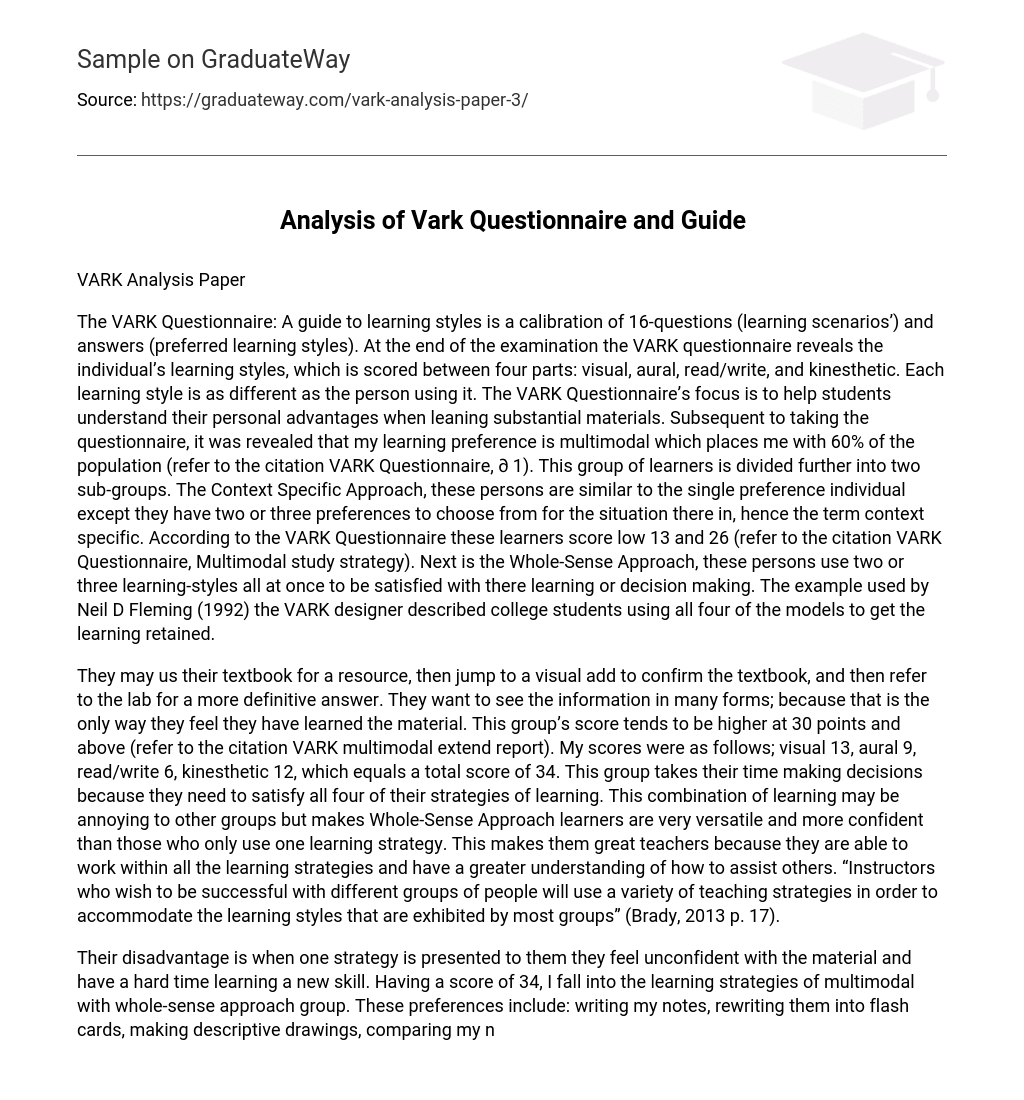VARK Analysis Paper
The VARK Questionnaire: A guide to learning styles is a calibration of 16-questions (learning scenarios’) and answers (preferred learning styles). At the end of the examination the VARK questionnaire reveals the individual’s learning styles, which is scored between four parts: visual, aural, read/write, and kinesthetic. Each learning style is as different as the person using it. The VARK Questionnaire’s focus is to help students understand their personal advantages when leaning substantial materials. Subsequent to taking the questionnaire, it was revealed that my learning preference is multimodal which places me with 60% of the population (refer to the citation VARK Questionnaire, ∂ 1). This group of learners is divided further into two sub-groups. The Context Specific Approach, these persons are similar to the single preference individual except they have two or three preferences to choose from for the situation there in, hence the term context specific. According to the VARK Questionnaire these learners score low 13 and 26 (refer to the citation VARK Questionnaire, Multimodal study strategy). Next is the Whole-Sense Approach, these persons use two or three learning-styles all at once to be satisfied with there learning or decision making. The example used by Neil D Fleming (1992) the VARK designer described college students using all four of the models to get the learning retained.
They may us their textbook for a resource, then jump to a visual add to confirm the textbook, and then refer to the lab for a more definitive answer. They want to see the information in many forms; because that is the only way they feel they have learned the material. This group’s score tends to be higher at 30 points and above (refer to the citation VARK multimodal extend report). My scores were as follows; visual 13, aural 9, read/write 6, kinesthetic 12, which equals a total score of 34. This group takes their time making decisions because they need to satisfy all four of their strategies of learning. This combination of learning may be annoying to other groups but makes Whole-Sense Approach learners are very versatile and more confident than those who only use one learning strategy. This makes them great teachers because they are able to work within all the learning strategies and have a greater understanding of how to assist others. “Instructors who wish to be successful with different groups of people will use a variety of teaching strategies in order to accommodate the learning styles that are exhibited by most groups” (Brady, 2013 p. 17).
Their disadvantage is when one strategy is presented to them they feel unconfident with the material and have a hard time learning a new skill. Having a score of 34, I fall into the learning strategies of multimodal with whole-sense approach group. These preferences include: writing my notes, rewriting them into flash cards, making descriptive drawings, comparing my notes with other students and asking for feedback, describing lecture in my own words, checking accuracy of notes with online resources, and clarifying my notes with my instructor until answers are satisfied.
When comparing my preferred learning strategies with VARK identified strategies, I found them surprisingly similar. Being an artist I assumed I was strictly a visual learner preferring images, pictures, and demonstrations when learning. By taking the VARK Questionnaire I can see other ways that I learn information for example using kinesthetic, this explains my need for a real textbook vs. an e-book for studying. I am not satisfied unless I can smell, touch, and see my study material. My love for having light background noise when I study is in line with my aural preference and writing my notes over multiple times supplies my preference for my reading/writing study strategies. Looking to the future in regards to learning, changes I can make with the knowledge I gained from the VARK Questionnaire are as follows: become more aware of my study preferences and use them to my benefit, be more willing to educate my peers, and become more timely in my decision making. In conclusion, my analysis of the VARK learning style assessment is an excellent tool to use to find an individual’s learning style. The first thing is to get a person to do the questionnaire. I found it to be user very friendly with just enough questions. Second the questionnaire had a quick response when receiving your score.
Lastly the information that was provided by Neil Fleming was informative and helpful. With this added knowledge of my learning style I will make adjustments to my studying and embrace my multimodal study style. I will consider leading in my group projects as multimodal learns excel at educating others. Become more aware of the time I spend on decision-making and become more confident in the learning style that is presented to me. I found the VARK questionnaire to be fun and informative I will recommend it to other students to enlighten their views of there personal learning style.
References
Brady, C., (2013). Understnding Learning Styles: providing the optimal learning experience. International Journal of Childbirth Education vol. 28:2., April 2013, 17 Fleming, D. N., & Mills, C. (1992). Not Another Inventory, Rather a Catalyst for Reflection, To Improve the Academy. vol. 11. 1992., 137 VARK Multimodal extended study. Retrieved 10/03/2013, from http://www.vark-learn.com/english/page_content/multimodality.htm VARK Multimodal study strategy. Retrieved 10/03/2013, from http://www.vark-learn.com/english/page.asp?p=multimodal “VARK Questionnaire, How do I Learn Best ?” Retrieved 10/03/2013, from http://www.vark-learn.com/english/page.asp?p=questionnaire





